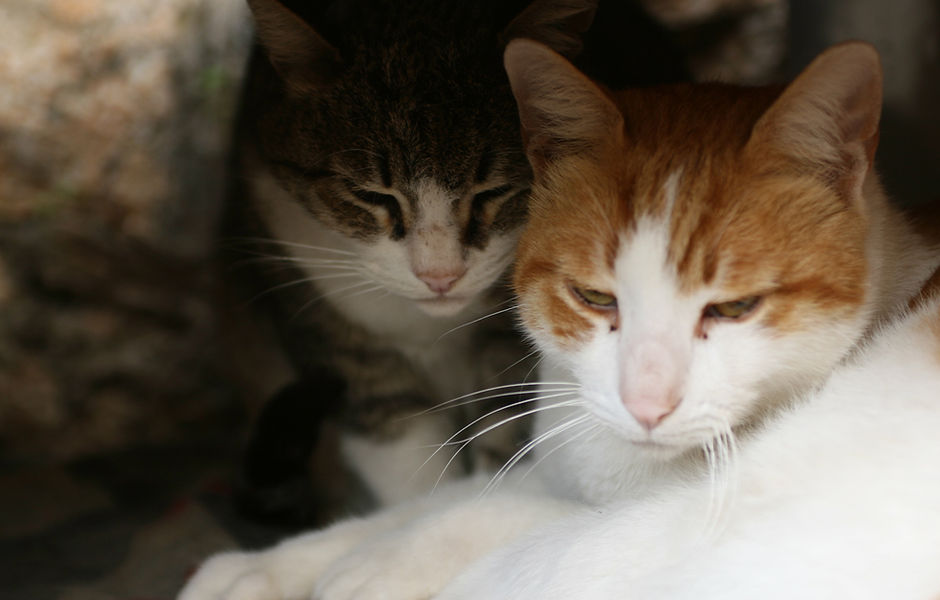
Think Vertically
Cats, even more than humans, feel stress when crowded by other cats. Unlike humans, they are very happy to use vertical space to increase their territory. "Cat trees," which give cats access to higher levels are very effective at reducing stress in multicat households. Other elevated areas, such as shelving units, tall furniture in general, window ledges, kitchen cabinets, and closet shelves can also increase the cat's perceived sense of space and territory and reduce stress. Some people have added cat walkways in their home at elevated levels to enrich their cat's environment and reduce negative interactions between cats.Anything that increases the perceived space available to the cats, improves their interactions amongst each other , reduces their stress, and enriches their lives can help with litter box problems. Increasing human positive human interaction with the cats are also very helpful at reducing litter issues. Sometimes antianxiety medication is essential to alleviate marking behavior. Improving litterbox availablity and attractiveness is essential.

"Can't I have a little privacy?!!!"
Multiple Cat Households
Domestic cats evolved as relatively solitary hunters, who spent time in social groups primarily during mating and raising young. As they became domesticated several thousand years ago, they became more accustomed to interacting in groups around preferred food sources such as farms with a plentiful source of rodents attracted to stored grain. Unlike dogs, however, they are not naturally pack type animals, and the presence of other cats is often stressful for cats. Consequently, litter box issues are far more likely to occur in multiple cat households than in single cat households. The more cats present in the household, the more likely litter box issues are to occur. Some research has found that 100% of households with 5 or more cats have had to address litter box problems.
Cats will quickly determine a social hierarchy when housed in groups. This hierarchy may be quite complex, with one cat being dominant in one location of the home and another in a different location. Some behaviorists find the evidence for dominant and subordinate relationships less compelling, but still note that cats may control territory and not allow other cats access to resources such as food, water and litter boxes in that territory.
Cats will develop routes or paths in the home to avoid crossing the path of the dominant cat, and will attempt to time the use of needed routes, such as the path to the litter boxes, to avoid the presence of the dominant cat in these routes. Unfortunately, some dominant cats will maintain control of these litterbox routes by simply lying down in the path. This then deters the subordinate cat(s) from using the litter box in an effort to avoid a negative interaction, and that cat needs to find an alternate location for elimination.
Adding additional litter box and food stations at opposite ends of the house from the current stations give an acceptable alternative location because the dominant cat cannot control both paths at the same time.
Put a bell on the collar of the dominant cat to allow the subordinate cat to hear it coming and avoid it when necessary.
Do not break up inter cat "squabbles" unless one of the cats is getting physically hurt. The more you intervene, the more you are rewarding the fighting with attention and the longer it will take for the cats to detemine their place in the hierarchy. Do not give attention to the subordinate cat after a fight as this rewards again the continued fighting.
Introducing new cats into the household increases stress as the original cats(s) defend both their territory against the newcomer and their position in the social hierarchy. The newcomer must accept a subordinate position in the hierarchy or force himself (as dominant cats are usually males) into the top position. It is normal behavior for a cat to defend their territory by marking it with urine or stool. Consequently both the original cats and the newcomer may urinate or defecate outside the box as part of defending their social status. This behavior can be reduced by slowly acclimating new cats into the household and giving large amounts of positive reinforcement to the original cats. In addition, younger and spayed and neutered cats more readily assume subservient social status and therefore usually integrate more readily.
